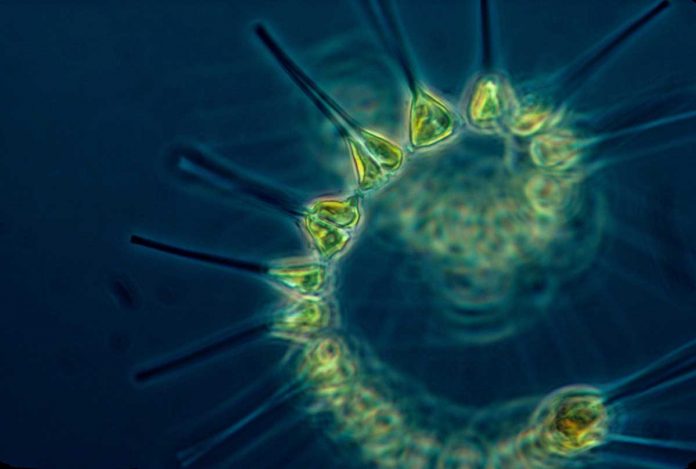The climate of Earth is a very complex process that is driven by the subtle balance of many different processes. A main process among them is the air-sea exchange of CO2. The ocean’s uptake of CO2 is an important thing to understand climate change. Scientists from EPFL and Mediterranean Institute of Oceanography have discovered a new part of the process. Scientists have identified a new source of organic phosphorus derived from the atmosphere and it gradually help phytoplankton and microalgae growth. Microalgae growth plays a crucial role in making our planet habitable. Organic phosphorus deposition to marine environments is still undiscovered to scientists. But the new research shows it is an important source of the critical nutrient that have important implications for climate. The findings of the research have been published in the journal npj Climate and Atmospheric Science.
Phytoplankton lives on the surface layers of lakes, seas and oceans and need a variety of chemical elements to grow. The main chemicals are iron, nitrogen and phosphorus. The nutrients help phytoplankton to bloom and carry out the critical function of photosynthesis. During this time, large amounts of CO2 is absorbed from the air and they convert it into biomass and release oxygen. This reason makes them highly important to living organisms and they have a crucial role in regulating the Earth’s climate. Phytoplankton forms the base of the aquatic food chain to sustain marine systems.
Phosphorus’s supply and bioavailability affects the growth rate of phytoplankton and the rate at which they photosynthesize which included the amount of CO2 they absorb. So, it is important to identify all the ways in which marine ecosystems are fertilized. This will provide us with key insights into the climate system and how human activities affect it.
The complete picture
The study’s lead author and a scientist at the Laboratory of atmospheric processes and their impacts, Kalliopi Violaki said “Scientists already knew that large amounts of inorganic phosphorus are transported to marine ecosystems by airborne dust in the form of phosphate minerals and ions. But this is an incomplete picture.”
Violaki organized a two year-long research program at the MIO. She discovered that bioaerosols, airborne biological particles, like viruses, bacteria, fungi, plant fibers and pollen have significant amounts of organic phosphorus inside them. Though she could not discover the exact amount of it. But it is significant as it is comparable to the amount of inorganic phosphorus that is supplied by dust aerosols. Organic phosphorus is also found in the form of phospholipids which is a key component of cell membranes.
Head of LAPI and co-author of the study, Athanasios Nenes said “Being aware that terrestrial ecosystems can fertilize marine ecosystems via bioaerosols gives us a completely new perspective. This knowledge will help us better understand the processes that influence the carbon cycle and the climate.”
An important discovery
Organic phosphorus is not yet incorporated into climate models. But it can bring a major improvement in our understanding of how marine ecosystems respond to the ongoing climate crisis. Ocean layers differ from each other in density, temperature, oxygen level and salinity. Further changes are adding themselves in this list because of climate change. It is making mixing between the layers more difficult and disrupting CO2 absorption. Ocean is becoming more stratified and it is getting harder for the nutrients available in the deep sea to reach the various layers of the ocean. This is impacting marine habitats and the food supply for various marine species. Especially in those areas that have limited phosphorus supplies. The new source of phosphorous is going to change how the Mediterranean and other oceans are predicted to respond to a changing climate.
The study emphasis upon the importance of atmospheric particles to the environment. Variations in the supply of atmospheric particles can cause major changes to the whole climate system.

